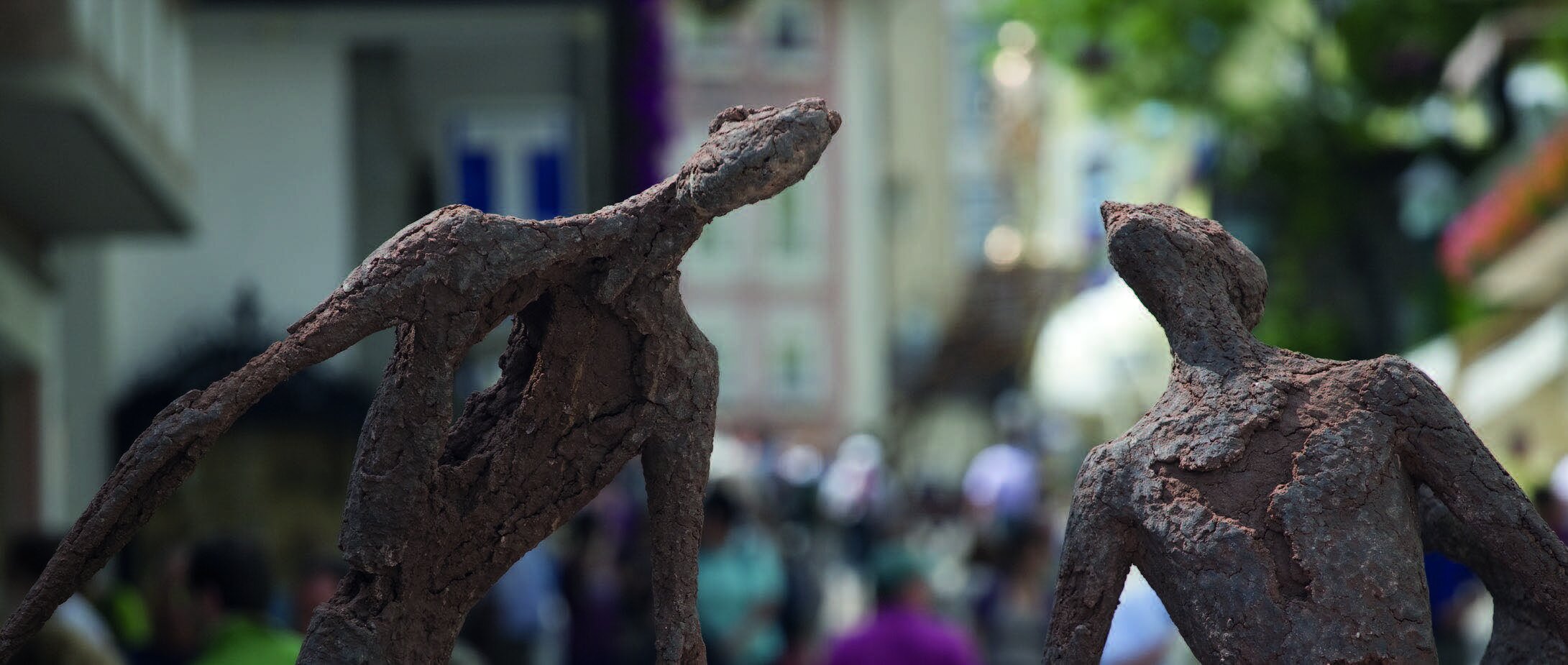
Gerald Moroder
*1975, Italy
lives and works in Munich, Germany
EN
"Dematerialisation of Being" - Gerald Moroder's narrow and dematerialised sculptures are made of the red porphyry rock of the Raschötzalm, on whose slopes Ortisei lies.
In this quest of his, the materials of the earth are placed in the foreground, almost privileged because of their still-healing power of collision with the image of reality and contemporary man. Penetrated by the moods that can be gathered in the productive nature of his existence, the sculptor wants to have a different experience with the earth, the stone and the wood mass each time. Through these ancient materials, he insists on seeking a configuration that corresponds to the sense of a rupture with the world, or an injury, or a tear with the existent, to be filled up by an embrace. The important thing for the artist is not to feel excluded from the desire to belong to Mother Earth, to descend into her magma and ascend again to heaven, and thereby to bring the work from earthly impurity to heavenly purity, and conversely from the purity of the idea to the impurity of language.
The lean and long-limbed figures sculpted by the artist are individual images of the successive phases of bodily dematerialisation, presented in sequence in an ideal whirlpool. This human being tries to achieve a form of lightness, dissolution and untouchability of existence. The disintegration of matter defies the laws of gravity. The rotation of the body is reflected in a tumbling upwards, a reflection of the striving towards a higher being.
IT
“Smaterializzazione dell’essere” - Le sculture sottili e smaterializzate di Gerald Moroder sono costituite della stessa roccia rossa di porfido del Monte Rasciesa, alle cui pendici sorge Ortisei.
In questa sua ricerca sono i materiali di terra a essere pos-ti in primo piano, quasi privilegiati per la loro intatta forza d’urto con l’immagine della realtà e dell’uomo contempo-raneo. Con la terra, la pietra, l’impasto di legno lo scultore vuole fare un’esperienza ogni volta diversa, pervaso dagli umori che si possono raccogliere dentro la natura produt-tiva del suo esistere. Attraverso queste materie antiche egli si ostina a cercare una configurazione che corrisponda al senso di una frattura con il mondo, o di una ferita, o di una lacerazione con l’esistente da colmare con un ab-braccio. Per lo scultore l’importante è non sentirsi esclu-so dal desiderio di appartenere alla terra madre, di entrare nel suo magma e di risalire fino al cielo, portando l’opera dall’impurità terrestre alla purezza celeste, e viceversa dalla purezza dell’idea all’impurità del linguaggio.
In un ideale vortice circolare, le figure magre e longilinee modellate dall’artista sono dei fotogrammi dello stesso uomo colto in fasi successive di smaterializzazione corpo-rea che vuole approdare a una forma di levità, di dissolven-za, di intangibilità dell’essere. La frantumazione della mate-ria si oppone alle leggi della gravità, la torsione del corpo si riflette in un fremito verso l’alto, traducendo l’anelito verso un’entità superiore.
DE
„Entmaterialisierung des Seins” - Die schmalen und entmaterialisierten Skulpturen Gerald Moroders bestehen aus dem roten Porphyrgestein der Raschötzalm, an deren Hängen St. Ulrich liegt.
In dieser seiner Suche werden die Werkstoffe der Erde in den Vordergrund gestellt, aufgrund ihrer noch heilen Kraft des Zusammenstoßes mit dem Abbild der Realität und des zeitgenössischen Menschen beinahe privilegiert. Durch-drungen von den Stimmungen, die man in der produktiven Natur seiner Existenz sammeln kann, will der Bildhauer mit der Erde, dem Stein und der Holzmasse jedes Mal eine andere Erfahrung machen. Durch diese antiken Werkstoffe beharrt er darauf, eine Konfiguration zu suchen, die dem Sinn eines Bruchs mit der Welt, oder einer Verletzung, oder einem Riss mit dem Existierenden entspricht, die durch eine Umarmung aufzufüllen sind. Das Wichtige für den Künstler ist, sich nicht von dem Wunsch, Mutter Erde an-zugehören, in ihr Magma hinab zu steigen und wieder bis in den Himmel aufzusteigen, ausgeschlossen zu fühlen, und dabei das Werk von der irdischen Unreinheit zur himmli-schen Reinheit, und dem entgegengesetzt von der Reinheit der Idee zur Unreinheit der Sprache zu bringen.
Die vom Künstler geformten mageren und langgliedrigen Figuren sind in einem ideellen Strudel in Sequenz darge-stellte Einzelbilder der aufeinanderfolgenden Phasen kör-perlicher Entmaterialisierung. Dieser Mensch versucht eine Form der Leichtigkeit, der Auflösung und der Unberühr-barkeit des Daseins zu erreichen. Die Zertrümmerung der Materie widersetzt sich den Gesetzen der Schwerkraft. Die Drehung des Körpers reflektiert sich in einem Taumel nach oben, ein Abbild des Strebens zu einem höheren Wesen.


